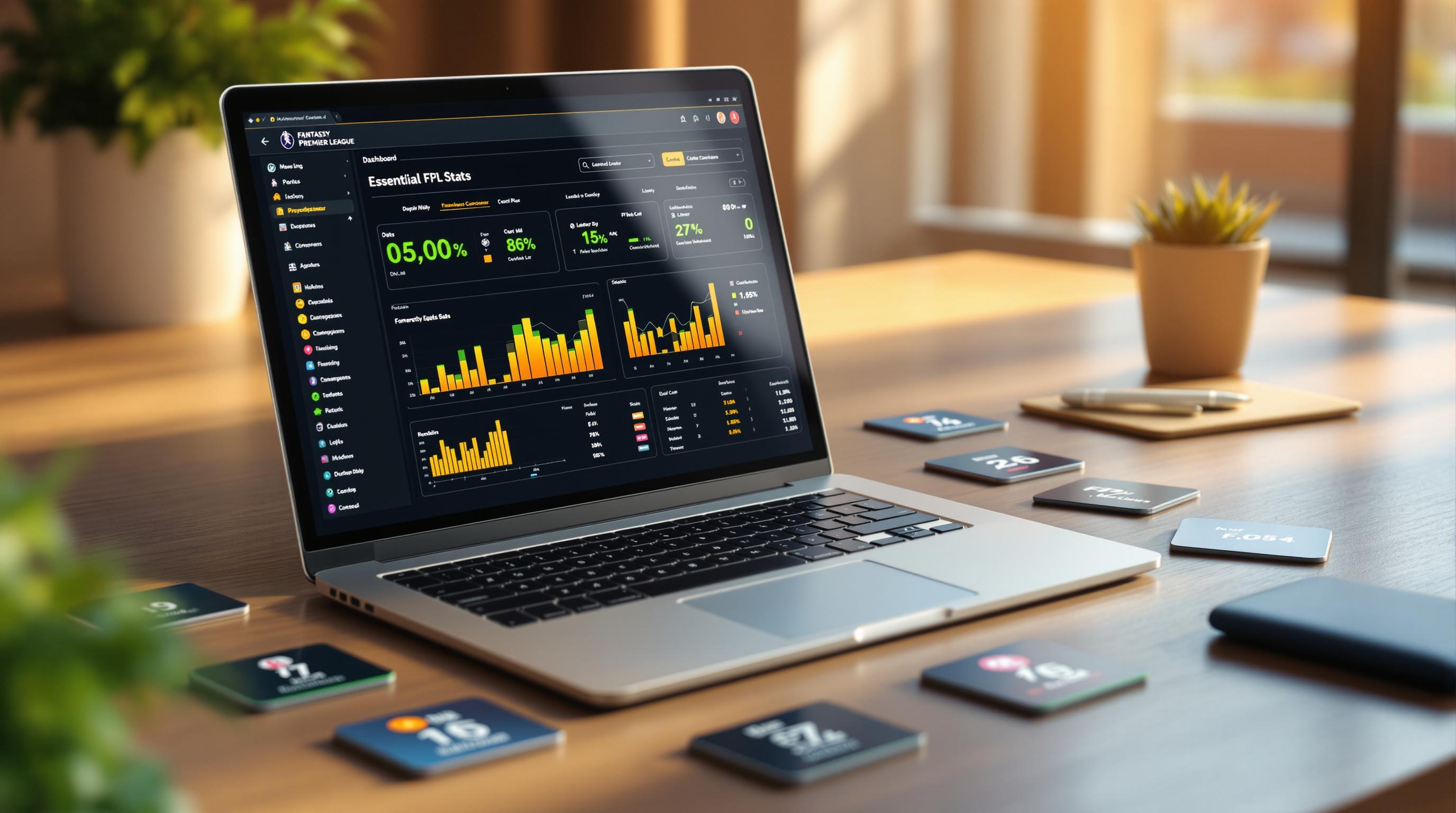Want to make smarter FPL transfers? Use xG (Expected Goals) data to predict player performance and stay ahead of the competition. Here's how xG can help:
- Spot High-Potential Players: Look for players with high xG but few goals - they might be due for a scoring streak.
- Avoid Overperformers: Players with low xG but many goals may not sustain their form.
- Use Team Trends: Teams with rising xG or low xGA (Expected Goals Against) point to better attacking or defensive options.
- Position-Specific Insights:
- Forwards: Prioritize high xG per 90 minutes.
- Midfielders: Combine xG and xA (Expected Assists) for balanced performers.
- Defenders: Focus on teams with strong xGA.
Where to Find xG Data: Platforms like Understat, Fantasy Football Scout, and FPL Review offer detailed xG stats and trends.
Start using xG data today to make informed, long-term FPL transfer decisions and maximize your points!
What is xG? | By The Numbers
Where to Find and Use xG Data
If you're serious about making smarter FPL decisions, getting reliable xG (expected goals) data is a must. It can help you spot trends, evaluate players, and fine-tune your transfer strategy.
Best Sources for xG Stats
- Official FPL Site: Offers basic xG stats, a solid starting point for beginners.
- Fantasy Football Scout: Provides historical xG data and trend analysis to help you track player performance over time.
- fplreview.com: Known for its long-term planning tools and fixture difficulty ratings, perfect for strategists [1].
- Understat: Features visual tools like shot maps, making it easier to track xG data across matches [5].
Each platform brings something unique, so pick one (or a mix) that fits your style.
Key xG Metrics to Know
Understanding xG metrics can help you make sharper transfer decisions. Here’s a quick overview of the most useful ones:
| Metric | What It Means | How to Use It in FPL |
|---|---|---|
| xG per 90 | Expected goals per match | Pinpoints consistent goal-scoring players |
| xG vs. Actual Goals | Compares expected goals to actual goals | Flags overperformers or underperformers |
For example, Manchester City averages 1.94 xG per game, making their attackers highly appealing for FPL managers. On the other hand, Arsenal’s league-best 1.09 xGA (expected goals against) suggests their defenders are a solid choice [4].
When analyzing xG, keep an eye on players with high xG but low actual goals. They might just be on the verge of delivering big returns. That said, consistently poor conversion rates could point to issues with finishing rather than just bad luck.
With these tools and insights, you're better equipped to use xG data to your advantage in FPL.
sbb-itb-2e37f13
How to Use xG for Smarter Transfers
Making informed transfer decisions is key to thriving in FPL. Here's how to use xG data to pick the best players for your team.
Spotting Players with High Potential
Finding players on the brink of a scoring streak can give you an edge. Pay attention to these patterns:
| Performance Indicator | What It Means | Action to Take |
|---|---|---|
| High xG, Low Goals or Rising xG Trend | The player is getting strong scoring chances but hasn't converted yet | Consider adding them before their form improves |
| Frequent shots from high-quality areas | Consistent opportunities in dangerous areas | Evaluate their potential for your squad |
For example, if a striker averages an xG of 0.5 per game but has only scored 2 goals in 10 matches, they’re likely underperforming. These players often deliver great value before their form picks up [1].
Avoiding Players Likely to Decline
It's equally important to spot players whose performance might dip. Be cautious of players overachieving their xG. For instance, a midfielder with an xG of 0.1 per game but 5 goals in 10 matches is likely overperforming. This kind of unsustainable form often leads to reduced returns, making them a potential sell candidate [2].
Recognizing these trends can help you avoid wasting transfers and maintain a balanced team.
Using xG for Different Positions
xG insights vary depending on player roles. Here's how to approach each position:
- Forwards: Focus on xG per 90 minutes. Prioritize forwards from teams with strong attacking stats for consistent points.
- Midfielders: Look at both xG and Expected Assists (xA). A midfielder with high xA but limited assists might be a hidden gem if their teammates start finishing chances [1].
- Defenders: Use team xGA (Expected Goals Against) to identify defenses likely to keep clean sheets.
Combining xG with Other FPL Stats
Expected Goals (xG) is a great tool on its own, but pairing it with other Fantasy Premier League (FPL) stats can give you a clearer picture for smarter transfer decisions.
Using xG Alongside Points and Form
Points Per Million (PPM) measures how much value a player delivers based on their cost. When you combine xG with PPM and recent form, you can pinpoint players who are worth the investment:
| Metric Combination | Insights | What It Means for Transfers |
|---|---|---|
| High xG + Low PPM | Player is creating chances but not converting them | Could be a bargain if their form improves |
| High PPM + Low xG | Player might be overachieving | Selling before their performance dips could be wise |
| High xG + Strong Form | A consistent attacking threat | Likely a top transfer target |
For midfielders, combining Expected Assists (xA) with xG can be especially revealing. A midfielder with high xA but moderate xG could rack up points through both goals and assists, making them a strong all-round option [1].
You can also use xG trends to guide your team strategy over the long term.
Planning Ahead with xG Trends
Looking at team-level xG trends can help you make smarter transfer decisions. When evaluating future fixtures, keep an eye on patterns like these:
If a team’s xG is steadily rising - say, from 1.2 to 1.8 per game over five matches - it indicates growing attacking potential. This makes their attackers more appealing as transfer targets [1].
Pairing PPM with xG is also a great way to find undervalued players. This strategy is perfect for spotting differentials: players with high potential and low ownership.
Here are some key factors to consider:
- Fixture Difficulty: High xG against tough opponents is more meaningful than against weaker teams.
- Team Momentum: A rising team xG often translates to better individual returns.
- Consistency: Focus on steady xG improvements over several matches rather than one-off spikes.
Platforms like FPL Review and FootyStats combine these metrics to highlight trends, allowing you to act before others [3][4]. By analyzing xG trends, you can predict future performance and avoid making hasty, reactive transfers.
Keep in mind, xG trends are more reliable over longer periods. A sample size of five matches tends to offer better insights than just looking at the last couple of games.
Conclusion: Using xG to Improve Your FPL Team
Key Takeaways
xG data can be a game-changer when it comes to identifying transfer targets ahead of your competitors. By diving into these performance metrics, you can uncover hidden gems and make smarter decisions for your Fantasy Premier League team.
Here’s how you can use xG effectively:
| Strategy | How to Use It | What You Gain |
|---|---|---|
| Targeting Value | Pick players with high xG but few goals | Potential for better returns as form evens out |
| Spotting Trends | Monitor xG over 5+ matches | More accurate predictions of future performance |
| Team Selection | Prioritize teams with high xG | Steady points from consistent performers |
Platforms like FPLReview and Understat are great for accessing xG data and tracking trends. Instead of chasing quick wins, focus on steady, long-term performance patterns.
To get the most out of xG:
- Keep an eye on xG trends across several gameweeks for a clearer picture.
- Pair xG insights with fixture difficulty ratings for smarter planning.
- Look for teams showing an upward xG trend alongside favorable fixtures to maximize points.

